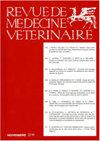用马绒毛膜促性腺激素限制母乳喂养和不母乳喂养同步牛排卵
Q2 Veterinary
引用次数: 1
摘要
为了最大限度地发挥牛的生产和遗传潜力,必须尽快实现奶牛的受孕。产后发情会长期影响生育,这与许多因素有关,包括小牛的存在和母性行为。目的:比较马绒毛膜促性腺激素(eCG)在有和没有限制护理的情况下对有足部小牛的失情婆罗门牛的排卵同步方案。方法:根据纳入标准,采用非概率抽样方法,从240头奶牛中选择184头,随机分配到1个处理中。进行了两组治疗和两组对照。使用孕激素和雌激素的排卵同步方案根据是否使用心电图和是否限制护理而有所不同。结果:使用独立样本的Pearson比例比较检验,可以确定,95%的置信度(p=0.8308),在同步方案中使用eCG时,“限制”和“不限制”护理的怀孕百分比无显著差异。结论:采用定时人工授精(FTAI)的方案,在不限制护理的情况下,在未发情的情况下进行心电图管理,是一种增加妊娠率和有利于犊牛繁殖的替代生殖管理方法。本文章由计算机程序翻译,如有差异,请以英文原文为准。
Sincronización de la ovulación en bovinos utilizando gonadotropina coriónica equina con amamantamiento restringido y sin este
Introduction : To make the most of the productive and genetic potential in cattle, it is necessary to achieve the conception of cows as soon as possible. Postpartum anestrus can affect fertility for a long time, which is associated with many factors, including the presence of calf and maternal behavior. Objective : To compare ovulation synchronization protocols using equine chorionic gonadotropin (eCG), with and without restricted nursing, in anestrous Brahman cows with calves at foot. Methodology : Of a total of 240 cows, 184 study animals were selected by non-probabilistic sampling, based on the inclusion criteria, and were randomly assigned to one of the treatments. Two treatments and two controls were carried out. Ovulation synchronization protocols using progestogens and estrogens varied according to whether they used eCG or not, and whether nursing was restricted or not. Results: Using Pearson’s proportion comparison test for independent samples, it was possible to determine, with 95% confidence (p=0.8308), that there were no significant differences in the percentage of pregnancies between “restricted” or “not restricted” nursing when eCG was used in the synchronization protocols. Conclusion: The use of protocols for ovulation synchronization for fixed-time artificial insemination (FTAI) with the administration of eCG in anestrus and without restricted nursing is an alternative reproductive management that increases the percentage of pregnancies and favors the breeding of calves.
求助全文
通过发布文献求助,成功后即可免费获取论文全文。
去求助
来源期刊

Revue De Medecine Veterinaire
农林科学-兽医学
CiteScore
1.30
自引率
0.00%
发文量
0
审稿时长
18-36 weeks
期刊介绍:
The Revue de Médecine Vétérinaire publishes four kinds of text:
1) Scientific reviews on subjects related to veterinary and comparative medicine. Suggested length: 10 to 30 typed pages.
2) Original reports on fundamental or applied research. Suggested length: 10 to 15 typed pages.
3) Continuous education articles, that should be easily understandable by non-specialists. Suggested length: 10 to 15 typed pages.
4) Clinical reports. Suggested length: 5 to 15 typed pages.
The publication can be done in French language or English language.
For an article written in English by not english native speakers authors, the manuscript must be subjected by attesting that it was read again by an anglophone scientist or a scientific translator.
The authors must certify that the manuscript was not published or subjected for publication to another review.
The manuscript must be accompanied by a sheet signed by all the joint authors indicating their agreement for the tender of the manuscript.
The publication is free but a financial participation could be required for the photographs color. An estimate will be sent to collect the agreement of the authors.
 求助内容:
求助内容: 应助结果提醒方式:
应助结果提醒方式:


